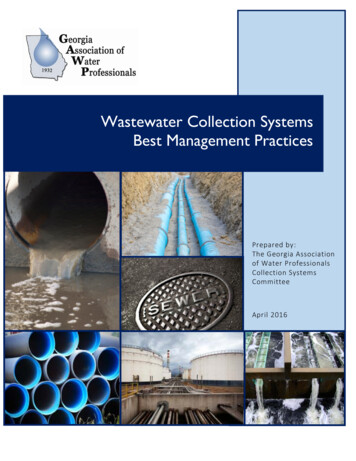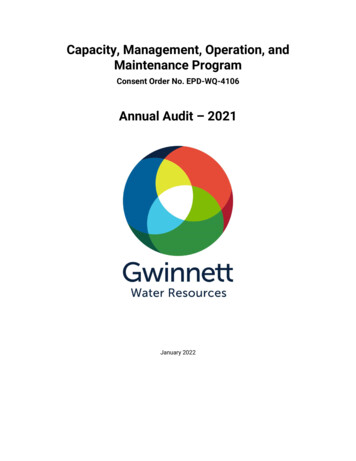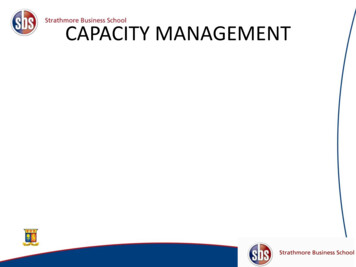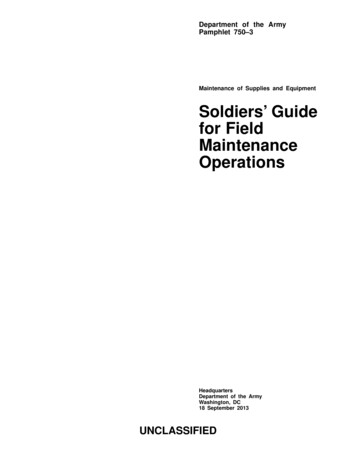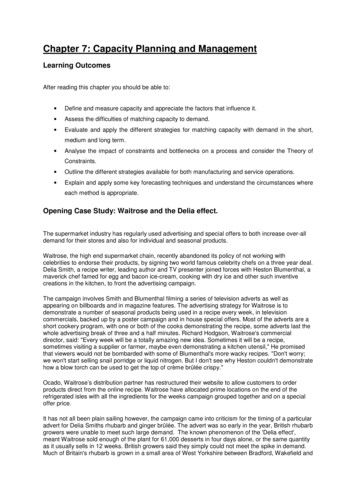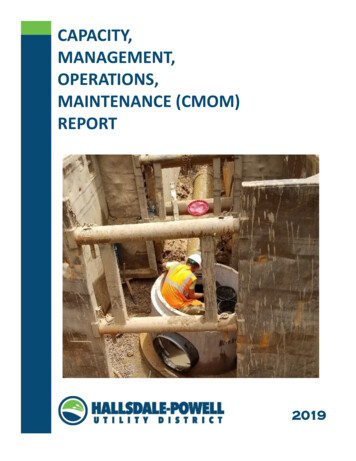
Transcription
CAPACITY,MANAGEMENT,OPERATIONS,MAINTENANCE (CMOM)REPORT2019
TABLE OF CONTENTSSECTION 1.0 - 2019 CMOM PROGRAM SUMMARYA. Certification StatementB. Purpose and ScopeC. Overview of HPUD InfrastructureD. Roles and Responsibilities for CMOM ProgramE. CMOM Program Overview1. Management Plan2. Performance Measures and Management Review3. Data and Asset Management4. Capital Improvements Plan5. Sewer Overflow Response Plan6. Fats, Oil, & Grease Program7. System Evaluation and Corrective Action Plan8. CMOM Communication PlanSECTION 2.0 - COMPLETED, ONGOING & PLANNED PROJECTSA. Completed, Ongoing, and Planned Collection System Projects FY 20191. Preventative Maintenance & Inspection Program2. Flow Monitoring3. Beaver Creek Interceptor Replacement Projects4. Brown Gap Interceptor Replacement Project5. Downtown Powell Sewer Rehabilitation Project6. North Fork Phase 2 Interceptor Replacement Project7. Bishop Road/Taggart Lane Sewer Improvements ProjectB. Completed, Ongoing, and Planned Wastewater Treatment Plant Projects1. Clarifier and Hydraulic Capacity Improvements ProjectC. Completed, Ongoing, and Planned Lift Station Projects1. Bright Lane Lift Station2. Temple Baptist Lift StationPage 1
SECTION 3.0 - SUPPLEMENTAL ENVIRONMENTAL PROJECTSECTION 4.0 - EDUCATION AND OUTREACH ACTIVITIESA. Utility Tours – HPUD Wastewater Treatment PlantB. Halls Outdoor Classroom SponsorC. Brickey-McCloud Elementary School STEM NightD. Job Fairs and Ride to Decide ProgramE. Knox Area Medication Collection ProgramF. Other Education/Outreach with Local SchoolsG. WaterFest - Community Water EducationH. Professional MembershipsSECTION 5.0 - CHANGES TO CMOM PROGRAM AND CORRECTIVE ACTION PLANA. Engineering Support and ManagementB. Financial ManagementSECTION 6.0 - OVERVIEW OF FIVE-YEAR CAPITAL IMPROVEMENTS PLANSECTION 7.0 - SUMMARY OF CMOM PROGRAM IMPLEMENTATIONPage 2
TABLE OF CONTENTS - APPENDICESAttachment 1:Attachment 2:Attachment 3:Attachment 4:Attachment 5:Attachment 6:Attachment 7:Attachment 8:Attachment 9:Attachment 10:Page 3Spreadsheet - Performance Measures and ManagementSpreadsheet – Sewer System Capital Improvements PlanMap - CMOM Projects and Chronic SSOsMap – 2019 SSO LocationsMap - Long-Term Flow Monitor LocationsMap – Beaver Creek Interceptor Replacement ProjectsMap – Brown Gap Interceptor Replacement ProjectMap – Downtown Powell Sewer Rehabilitation ProjectMap – North Fork Phase 2 Interceptor Replacement ProjectSpreadsheet – Updated CAP/ER Projects List
SECTION1.0 - 2019 CMOM PROGRAM SUMMARY/-X\A.CertificationStatementThis 2019 Annual Report is submitted to fulfill the requirements of Hallsdale-Powell UtilityDistrict’s (HPUD’s)Consent Order #WPC-14-0044 as agreed upon in August 2014. This ConsentOrder is a legal agreement between the TennesseeDepartment of Environment &Conservation(TDEC)and HPUD.The purpose of the ConsentOrder is to addresssanitary seweroverflows (SSOs)in the HPUDsanitary sewer system in an effort to improve water qualitythroughout HPUDservicearea. In accordancewith the 2014 ConsentOrder, this report detailsthe results of activities undertaken during the annual reporting period beginning January 1,2019 and ending December 31, 2019.Theformat of this report will follow the outline presentedwithin the Tableof Contentsand ispresentedin responseto the information requested in the ConsentOrder. All pertinent andsupplemental data, maps and background documentation will be retained on file in the mainoffice located at 3745 CunninghamDrive, Knoxville,Tennesseeand is available upon request.4- / -Z'26SignaturePage 14Date
\B.Purpose and ScopeThe Capacity, Management, Operation, & Maintenance Program (CMOM ) Annual Reportprovides a summary of CMOM Program activities (past and planned) and is intended to be acommunication tool. The report is intended for District staff, regulatory authorities, customers,and the general public. The report serves four general purposes:C. To provide an annual overview of the activities completed under the CMOM Program; To describe and document changes to the CMOM Program on an annual basis, whichmay include changes to objectives, strategies, and performance measures; To describe the activities that are planned or currently being undertaken to support theCMOM Program; To continue compliance with the August 2014 Agreement between the District and Stateof Tennessee, Department of Environment and Conservation (TDEC) which requires thatHPUD provide an annual report regarding implementation and performance of theCMOM program.Overview of HPUD InfrastructureHPUD’s wastewater system serves approximately 25,946 wastewater connections whichcovers an area of roughly 146 square miles. The District runs from North Knox County intoUnion County and extends into portions of Anderson County.The District has more than 476 miles of sewer mains buried below the 146 square miles ofHPUD’s service area. HPUD maintains a 5 million gallon (MG) sewer storage tank, 22wastewater lift stations, 9,656 manholes, and operates an on average 9.82 million gallon-perday (MGD) wastewater treatment plant, which uses an advanced membrane bioreactortreatment technology.Page 5
\Figure 1. HPUD’s Wastewater InfrastructureNo. of Sewer ConnectionsService AreaWastewater Treatment PlantsDecentralized Treatment PlantsRated Treatment Plant CapacityDaily Max WWTP FlowTreated WastewaterSewer Storage TankWastewater Lift StationsSewer ManholesForce Main & Gravity SewerD.25,946146 square miles229.7 million gallons per day21.7 million gallons per day2.87 billion gallons per year5 MG capacity229,656476 milesRoles and Responsibilities for CMOM ProgramThe Sewer Collection Department, under the direct supervision of the Collection System ProjectSupervisor, includes a staff of full-time employees who divide their time between operationand maintenance of the sewer collection system. HPUD’s Chief Operating Officer also devotessignificant time to the management and oversight of the sewer collection system.Figure 2. Roles and Responsibilities for CMOM ProgramTitleBoard of CommissionersGeneral ManagerAssistant General ManagerChief Operating OfficerManager of Field OperationsPage 6Role or ResponsibilityDevelops policy for DistrictManages all personnel, procurement, budget,operations, and management of HPUD departmentsand activitiesServes as the assistant to the General Managerand has the authority to conduct the sameduties/responsibilities as the General Manager,under his direction and approval.Manages the daily operation of all water andwastewater facilities, water distribution, sewercollection and construction activitiesManages HPUD the operations/crews for thecollection and distribution systems on a daily basis.
\Directs HPUD’s daily sewer operations, responds toCollection System Project Supervisorsewer problems, assists engineer/contractor onsewer projects, implements the SORP.Manager of Safety, Environmental and Managessafetyprocedures,environmentalField Servicesprograms, and oversees daily field servicesOversees education and outreach efforts withSafety and Education Coordinatorschools, residents, and local businesses.E.CMOM Program OverviewThe CMOM Program provides a method for HPUD to document current activities that areintended to help HPUD achieve goals related to control or elimination of sanitary seweroverflows, to improve effluent quality, and to ensure adequate system capacity. As part of thiseffort, HPUD has completed this 2019 annual review of the Program in conjunction withevaluating the performance measures outlined in the Program.1. Management PlanThe CMOM Program Annual Report provides a summary of CMOM Program activities. Thereport is intended for District staff, regulatory authorities, customers, and the general public.HPUD’s CMOM Management Plan describes the approach that the District is undertaking toensure all necessary activities and programs are in place in order to support the CMOMProgram.Each year, the annual report details the progress toward meeting objectives of the Plan. Thefollowing is a list of the some of the major accomplishments that have helped move the CMOMProgram forward: Continued implementation of the Collection System Preventative MaintenanceInspection (PMI) Program in order to identify, pinpoint, and prioritize areas of thecollection system that need rehabilitation or replacement; Use of the Geographic Information System (GIS) data as the basis for the assetmanagement system for collection system & treatment plant infrastructure.Page 7
\2.Performance Measures and Management ReviewThe review of the performance measures is intended to be an evaluation of the District’s statuswith respect to achieving its CMOM objectives. The purpose of the performance measures is totrack District activities over time and gauge achievement of CMOM program objectives. Someof these performance measures have been selected as key measures to gauge the overallperformance of HPUD in the areas of collection system operations and maintenance andcapacity assurance. (See Attachment 1: Performance Measures and ManagementSpreadsheet).3. Data and Asset ManagementThroughout 2019, the District continued to improve asset management processes and dataquality and accuracy. The District continues to evaluate and monitor the process of trackingcapital project costs at the asset level to verify the accuracy of these assets and costsassociated with them.HPUD continues to utilize Cityworks and Geographic Information System (GIS) totrack and evaluate assets. Cityworks is used to track customer issues, service requests, andwork orders HPUD receives on a daily basis. HPUD uses GIS to track and locate upgrades andchanges to the sewer system. HPUD also uses GIS as a tracking and assessment tool for PMIwhich helps evaluate assets to develop rehabilitation and construction projects. Theserehabilitation projects are then entered in the Combined Rehab database and shown in GIS.4. Capital Improvement PlanHPUD utilizes the 5-year Capital Improvements Plan (CIP) to ensure adequate financialresources are set aside to fund required components of the sewer capital improvements plan.The CIP is discussed in more detail in Section 5.0 of this report and a summary of the plan isincluded in Appendices as (See Attachment 2: Sewer System Capital Improvements Plan(CIP)).Page 8
\5. Sewer Overflow Response PlanThe Sewer Overflow Response Plan (SORP) describes the measures the District has put inplace for response, containment, clean up, stream sampling and analysis, public notification,and regulatory reporting of overflows in the collection system. The SORP details the steps tobe taken when a potential overflow is identified, categorization of whether it is a wet weatheror dry weather SSO, and if it reaches State Waters.Historically, the District has collected data about pipe defects, line blockages, mechanical orelectrical equipment problems, and inflow and infiltration, which are the primary causes ofsanitary sewer overflows. The Sewer Operations and Maintenance Superintendent has adedicated staff that oversees operation and maintenance activities in the collection system,including SSO response and clean up.The Sewer Operations and Maintenance Superintendent maintains the SSO trackingspreadsheet. Overflow data is also incorporated into the GIS. The following section of thisreport details specifics about SSO data captured during this reporting period.(See Attachment 3: Map - 2019 SSO Locations)The majority of HPUD’s chronic SSOs occur in wet weather and are located on the Interceptorline or a manhole or two upstream of the Interceptor line. To try and alleviate this issue,HPUD has began replacement of approximately 30,000 linear feet of the Interceptor line tohelp convey the wastewater to wastewater treatment plant and allow for more capacity.HPUD is also focusing on upgrading sewer mains in areas of known SSOs.(See Attachment 4: Map – CMOM Projects and Chronic SSOs)a. Summary of SSO DataFor the 2019 calendar year, there were a total of 177 SSOs (Jan 1, 2019 to Dec. 31,2019) due to either operational issues or wet weather events throughout the HPUDservice area. A total of 161 of the discharges were due to wet weather events andcaused by inflow/infiltration. The other 16 discharges were dry weather overflows asreflected in the following chart.Page 9
\Of the 16 recorded dry weather SSO events during the 2019 annual reporting period, most werecaused by operational issues such as line blockage, roots, or debris. The majority of the SSO’s(161) were caused by wet weather issues attributed to inflow and infiltration. All SSOs areperiodically reviewed to identify if any problems exist that warrant the need for a larger-scaleinspection or rehabilitation projects.b. Summary of SSO Events by CauseAll SSOs, regardless of the cause, are immediately responded to and the problems areremediated as soon as possible. Parts of the collection system, where blockages occur,are put on a cleaning program to be inspected and cleaned as needed, or placed on aschedule for rehabilitation or replacement. The following chart depicts a summary ofSSO events by cause for the 2019 calendar year.Page 10
\6. Fats, Oil, & Grease ProgramAs part of the Fats, Oil, & Grease Program (FOG), HPUD has continued to outsource greasetrap inspections. Since late 2009, HPUD has contracted with Robert G. Campbell & Associates(RGC&A) to conduct grease and grit trap inspections. For the calendar year of 2019, RGC&Aconducted 526 inspections on 175 businesses. The frequency of the inspections varies as tothe type of business and whether follow up inspections are necessary.Contracting with a third party for inspections and management of the program has enabledHPUD Collection System staff to be more effective in the operation and maintenance of thecollection system. HPUD staff periodically review inspection reports and update the writtenFOG Program as often as necessary.HPUD started a “Can the Grease” campaign. Customers are encouraged to pick up a greasecan lid to cover the grease until it cools and can be disposed of properly. This campaign offersresidential customers a solution to grease disposal.7. System Evaluation and Corrective Action PlanThe Corrective Action Plan & Engineering Report (CAP-ER) was submitted to TDEC on March 17,2015 and HPUD received approval on May 23,2015. In response to TDEC’s review of HPUD’sSystem Evaluation and CAP-ER, HPUD continues progress toward meeting the followingobjectives:Page 11
\ Continue to address HPUD’s Infiltration and Inflow (I/I) problem;Continue to identify collection system rehabilitation priorities;Complete Capital Improvement Projects;Continue the Preventative Maintenance Inspection (PMI) program;Continue with lift station improvements;Continue monitoring of HPUD’s nine (9) permanent flow monitoring stations.One of the tools utilized to develop the District’s CAP-ER is HPUD’s collection system hydraulicmodel. HPUD developed a collection system hydraulic model in 2005 and has sinceperiodically updated the model to reflect ongoing improvements to the collection system.Flow characteristics are calibrated by utilizing rainfall and flow monitoring information data.HPUD has nine permanent flow monitoring stations with three rain gauges currently in place.HPUD last updated the collection system model assets in 2019 to include the 5 MG Dry GapStorage Tank and 5,800 LF of 48” sewer while a 2014 calibration updated the flowcharacteristics. Using the updated model, HPUD reported a reduction in SSO’s from existingimprovements, with further decrease in SSO’s anticipated as a result of plannedsystem/interceptor related improvement projects.Hydraulic models require recalibration periodically to understand and update the flowcharacteristics within the model. HPUD is planning to perform the flow study andrecalibration of the model after the ongoing interceptor construction projects are completedin order to obtain the most accurate flows for the system and offer the best possible resultsfor calibration. This effort will include the implementation of temporary flow monitoring toisolate specific trouble areas, coupled with sewer system inspections to identify deficiencies.Defects identified as a part of this effort will be systematically addressed through systemimprovements and work associated with HPUD’s ongoing rehabilitation program.The updated and calibrated collection system hydraulic model was used to perform the capacityassessments. The objectives of the capacity assessment included the following objectives: Identify locations and causes of hydraulic constraints in the collection system;Assess the Beaver Creek WWTP ability to accommodate/treat peak flows,Assess how existing sewer system performance will be improved by plannedrehabilitation and improvement projects, andAssess the performance of planned rehabilitation projects to accommodate futurepopulation growth.Page 12
\8. CMOM Communication PlanThe CMOM Communication Plan documents the types and frequency of communications thatare prepared and distributed regarding the status of the CMOM Program and the CMOMAnnual Report. The District maintains communication with the Tennessee Department ofEnvironment and Conservation (TDEC), the Board of Commissioners, HPUD employees, andHPUD customers on a regular basis.The Board of Commissioners meet monthly to determine policy issues related to finance,personnel, operations, water and sewer system improvements, and other HPUD business. HPUDutilizes its quarterly customer newsletter, “WaterWorks”, the CMOM Annual Report, and adedicated website, www.hpudactnow.org, to inform customers about projects related to thesewer collection system. HPUD uses Twitter (@hpudknox) and Facebook, to keep customersinformed of projects and emergencies.Annual meetings are held which include a presentation of HPUD’s CMOM program, informationabout upgrades at the wastewater treatment plants, upgrades to collection systeminfrastructure, and a summary of data collected from inspections of the collection system.The past year’s activities included communication of the CMOM Program to the public througharticles in the customer newsletter, and a presentation to the Board of Commissioners on May13, 2019.SECTION 2.0 - COMPLETED, ONGOING AND PLANNED PROJECTSA. Completed, Ongoing, and Planned Collection System ProjectsThe major collection system projects that were completed, ongoing, and planned in 2019included the following:1. Preventative Maintenance & Inspection ProgramIn 2006, HPUD established a Preventative Maintenance and Inspection (PMI) Program totarget problematic areas in the collection system to help prevent sanitary sewer overflows(SSOs). The Preventative Maintenance and Inspection activities include techniques such asmanhole inspections, smoke testing, closed-circuit television (CCTV) inspection, preconditioning, and pipeline cleaning.Page 13
\Results of these investigations have been captured digitally and integrated into HPUD’sGeographic Information System (GIS). A final summary report is prepared detailing theproblems found and the priority in which they should be addressed. These problems or defectsare then put in a rehabilitation or construction project to be repaired by outside contractors orHPUD crews. HPUD is continuing to perform PMI work using in-house crews for inspections andoutside Contractors, as needed, in more concentrated areas that I/I is prevalent.2. Flow MonitoringOne of the key tools for enabling Hallsdale-Powell Utility District to analyze the performance ofthe sewer collection system is flow monitoring. Since 2004, HPUD has maintained continuousFlow Monitoring Units throughout the collection system. These flow monitoring devices havebeen installed within selected manholes at locations which are able to provide the bestinformation to HPUD about how the collection system is performing on dry days and wetweather days.During 2019, the Hallsdale-Powell Utility District continued long-term flow monitoring at ninelocations, along with rainfall monitoring at three locations. During 2019, the average flowobserved was 8.15 million gallons per day (mgd). HPUD saw a peak flow of 27.6 mgd and lowflow of 4.03 mgd. (See Attachment 5: Map - Long-Term Flow Monitoring Locations)3. Beaver Creek Interceptor Replacement ProjectsPhase 1: The Beaver Creek Interceptor Improvement Project consists of replacing the existing36-inch diameter interceptor beginning at the Beaver Creek WWTP and continuing forapproximately 10,900 linear feet into the HPUD collection system near Powell PresbyterianChurch in Powell.The existing interceptor will be replaced with a new 48-inch diameter interceptor,accompanying manholes and other structures, 300 linear feet of sewer line near West EmoryRoad and Clinton Highway, and 2,200 linear feet of sewer line replacement. An additional14,500 linear feet of lines and manholes are planned to be rehabilitated as part of the project.Jacobs Engineering rebid this project in October 2019 and the project was awarded to GarneyConstruction. Prior to the rebid, the original contractor had installed approximately 1,060 LF of48” pipe and 7 manholes. The project duration is 670 days, making the final completion onDecember 2021. Garney Construction began work at the end of February 2020.Phase 2: The Beaver Creek Interceptor Improvement Project Phase 2 is the continuation ofreplacing the existing 36-inch diameter with a new 48-inch diameter interceptor from wherePage 14
\Phase 1 stopped approximately 13,740 linear feet to Morton View Lane. The project alsoincludes the replacement of approximately 3,300 linear feet of gravity sewer line ranging from12-inch to 8-inch in diameter.Jacobs Engineering bid this project on January 7, 2020, and the project was awarded to ClearyConstruction. The Notice to Proceed is currently pending. The project duration is 900 days.Construction is set to begin late spring/early summer 2020. Completion of this project isestimated to be in December 2022.Phase 3: The Beaver Creek Interceptor Improvement Project Phase 3 continues with thereplacement of the existing 36-inch diameter interceptor from behind Morton View Lane to theeast side of Interstate 75. This project consists of approximately 5,500 linear feet of the new48-inch diameter interceptor along with the improvement of approximately 650 linear feet ofsmaller diameter pipes in the area.Robert G. Campbell & Associates (RC&A) awarded the project to Cleary Construction, Inc. withthe Notice to Proceed date of October 15, 2018. Cleary Construction completed this project andthe new 48-inch interceptor was in service as of October 2019. (See Attachment 6: Map –Beaver Creek Interceptor Replacement Projects)4. Brown Gap Interceptor Replacement ProjectThe Brown Gap Interceptor project will start at Brown Gap Road and go upstream to BeelerRoad. The project consists of upsizing the existing sewer mains which includes the following:approximately 10,140 linear feet of 21-inch diameter pipe, 658 linear feet of 16-inch diameterpipe, and 3,600 linear feet of pipe ranging from 12-inch to 8-inch in diameter. It also includesthe replacement of the existing manholes and service connections.Due to left over funds on the project, the scope has been increased to include the replacementof approximately 2,300 linear feet upstream. This will include the replacement of all manholesand service connections.Robert G. Campbell & Associates (RC&A) awarded the project to Hurst Excavating with theNotice to Proceed date of January 15, 2019. The project duration is 570 days making the finalcompletion date of August 2020. Currently, Hurst Excavating is approximately 56% completedwith the project. (See Attachment 7: Map – Brown Gap Interceptor Replacement Project)Page 15
\5. Downtown Powell Sewer Rehabilitation ProjectHallsdale-Powell Utility District is working with Robert G. Campbell & Associates (RGC&A) on arehabilitation project to upgrade the sanitary sewer system in downtown Powell. The projectincludes the gravity sewer main line pipe bursting of approximately 5.600 linear feet of 8-inchin diameter and 10,500 linear feet of cured in place pipe (CIPP). The project will alsorehabilitate/repair the sewer laterals and manholes associated with the main linerehabilitation.Robert G. Campbell & Associates (RC&A) awarded the project to Hurst Excavating with theNotice to Proceed date of February 17, 2020. The project duration is 330 days making the finalcompletion date of January 12, 2021. (See Attachment 8: Map – Downtown Powell SewerRehabilitation Project)6. North Fork Phase 2 Interceptor Replacement ProjectHallsdale-Powell Utility District is working with WK Dickson to design improvement options tothe North Fork Interceptor sewer due to overflows during large rain events and the futuredevelopment in the area. These improvements will begin at Ledgerwood Road and extendupstream toward Stillbrook Ln. WK Dickson is in the final design stages to develop theimprovement plans that will eliminate localized sanitary sewer overflows and increase capacityfor this area. This project is planned to bid Spring 2020. (See Attachment 9: Map – North ForkPhase 2 Interceptor Replacement Project)7. Bishop Road/Taggert Lane Sewer Improvements ProjectHallsdale-Powell Utility District is working with Cannon & Cannon, Inc. at options forimprovements to the sewer mains located around Bishop Road, E Emory Road, and TaggartLane due to overflows during large rain events, the potential of future development in the area,and the TDOT Bishop Road relocation project. These improvements will be concentratedaround Bishop Road at E Emory Road and extend to HPUD’s Interceptor line. Cannon & Cannon,Inc. is working to develop a plan for HPUD’s approval. This project is planned to bidSpring/Summer 2020.Page 16
\B. Completed, Ongoing and Planned Wastewater Treatment Plant ProjectsThe major wastewater treatment projects that were completed, ongoing, and planned in 2019included the following:1. Beaver Creek Clarifier and Hydraulic Capacity Improvements ProjectHallsdale-Powell Utility District is currently working with Fox PE on a project that consists ofimprovements to maximize capacity from clarifiers for peak loading. The project includesdemolition of the existing chlorine contact tank and installation of ultraviolet disinfectionequipment at the Beaver Creek WWTP. This project is planned to bid April 2020.C.Completed, Ongoing and Planned Lift Station ProjectsThe major lift station projects that were completed, ongoing, and planned in 2019 included thefollowing:1. Bright Lane Lift StationHallsdale-Powell Utility District is currently working with W.K. Dickson to relocate and redesignthe Bright Lane lift station. The new lift station will be repositioned on the same property thatit is on currently. When the project is complete it will be a completely new station with a newwet well, controls, etc. The discharge line will be rerouted to the location of the new lift station.These improvements will help upgrade the existing equipment along with helping withpotential future development in this area. The construction of this project is planned forsummer/fall 2020.2. Temple Baptist Lift StationHPUD is also working on improvements to the existing Temple Baptist Lift Station with W.K.Dickson. The improvements to this station will include new pumps and controls. Theimprovements to this lift station will allow HPUD to replace aging equipment and make the liftstation operate more efficiently. The construction of this project is planned for summer/fall2020.Lift station reliability continues to be a focus of the HPUD collection system improvementefforts. The District’s Capital Improvements Plan (CIP) has provisions for continued upgradesand rehabilitation of existing pump stations. HPUD personnel will continue to monitor thepump station’s performance within the collection system to determine if any sites will requiremajor rehabilitation in future years.Page 17
\SECTION 3.0 - SUPPLEMENTAL ENVIRONMENTAL PROJECTHPUD’s educational trailer, “Water on Wheels”, is used to educate students and communitymembers.Visit to Adrian Burnett ElementaryIn 2004, HPUD developed the “Water on Wheels” Program to educate area elementary schoolstudents about the importance of water quality and the impact it has on everyday life. Theselessons are aligned with the students’ science curriculum. The trailer makes visits to localelementary schools and is used in high school vocational programs for job fairs.During the past year, HPUD presented the program to about 400 students within the HPUDservice area. This hands-on activity is focused on educating students about the basiccomponents of the water treatment process.Beginning with a discussion about where our drinking water comes from, the students have anopportunity to learn about the potential contaminants that may be found in water sources andhow they might get there. Students learn concepts about “source water protection” and takingpersonal responsibility for water conservation and preserving water quality.Page 18
\SECTION 4.0 - EDUCATION AND OUTREACH ACTIVITIESA. Utility Tours - HPUD Wastewater Treatment PlantOne of the most significant educational outreach efforts that HPUD supports is to provide toursof the Beaver Creek Wastewater Treatment Plant. The water and wastewater industries havebecome more technologically advanced over time, so it is vital to attract young people intocareers within the industry.Some of the various groups that have toured the facility within the past few years are Halls HighSchool students, AmeriCorps students, West High School students, Grace Christian Academystudents, Halls Business & Professional Association student interns, and other communitygroups.AmeriCorps Students a tour of BCWWTP in October 2019Page 19
\B. Halls Outdoor Classroom SponsorThe H
E. Knox Area Medication Collection Program F. Other Education/Outreach with Local Schools G. WaterFest - Community Water Education . Conservation (TDEC) and HPUD. The purpose of the Consent Order is to address sanitary sewer overflows (SSOs) in the HPUD sanitary sewer system in an effort to improve water quality throughout HPUD service area .
